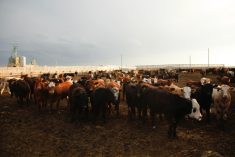Compared to last week, western Canadian feeder cattle markets traded $3-$5 on either side of unchanged. Many auction barns were closed last week and the ones holding sales had smaller numbers. Quality packages of yearlings were on the higher end of the range while smaller groups of fleshier replacements were discounted.
Alberta feedlots were focusing on local cattle this week, which took some of the steam out of the market in the non-major feeding areas. If buyers knew where the cattle came from, they had more confidence. At this time of year, backgrounded cattle can appear quite hard, as if they’ve been fed too much grain in the critical growing stage. Therefore, feedlots were incorporating discounts on cattle that to an untrained eye would appear unnecessary. These days, there are no bragging rights on margins and pencils are getting sharper and sharper. After last week’s firm tone, the market felt like a vacuum at times with limited buyers.
Read Also

Alberta crop conditions improve: report
Varied precipitation and warm temperatures were generally beneficial for crop development across Alberta during the week ended July 8, according to the latest provincial crop report released July 11.
In central Alberta, Angus-blended mixed steers with medium to heavier flesh weighing just under 950 lbs. sold for $165; a small group of similar-quality heifers weighing 925 lbs. were quoted at $145. In central Saskatchewan, there were some thinner cattle available. A smaller group of lower-flesh larger-frame mixed steers weighing 875 lbs. were valued at $172.
There was limited slippage in calf values. Demand from finishing feedlots was evident across the Prairies. Buyers are looking at securing yearling numbers for the August and September timeframe. Secondly, feed barley is expected to trade sub-$190 per tonne come the harvest period and with April 2020 live cattle futures hovering at $127, feedlots have room to bid up the feeder market.
In southern Alberta, larger-frame Charolais mixed steers weighing 525 lbs. were quoted at $249 while mixed heifers averaging 510 lbs. were valued at $219. In central Saskatchewan, the market was also quite firm with tan mixed steers weighing 615 lbs. moving at $220; a small group of Hereford-blended heifers averaging just over 615 lbs. reached up to $198.
Much of Western Canada has received less than 40 per cent of normal precipitation over the past 60 days. No farmer or feedlot is going to complain about dryness after our neighbours south of the border have suffered one storm after another; however, if these drier conditions prevail for another 30 days, this is going to be a problem.
— Jerry Klassen manages the Canadian office of Swiss-based grain trader GAP SA Grains and Produits Ltd. and is president and founder of Resilient Capital, specializing in proprietary commodity futures trading and market analysis. Jerry consults with feedlots on risk management and writes a weekly cattle market commentary. He can be reached at 204-504-8339.














